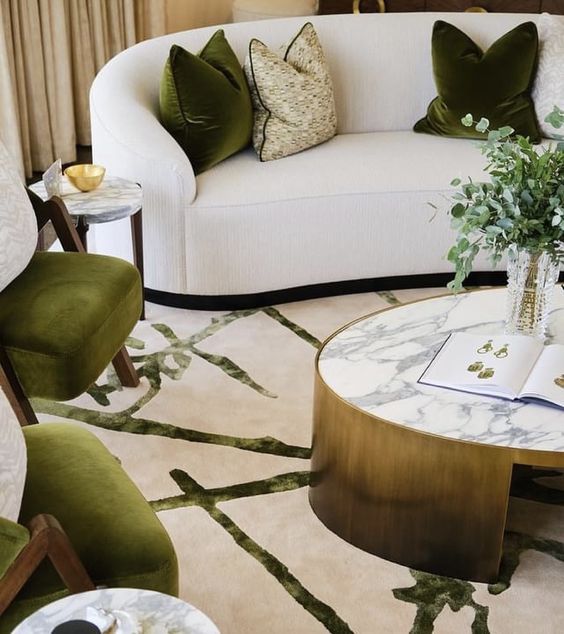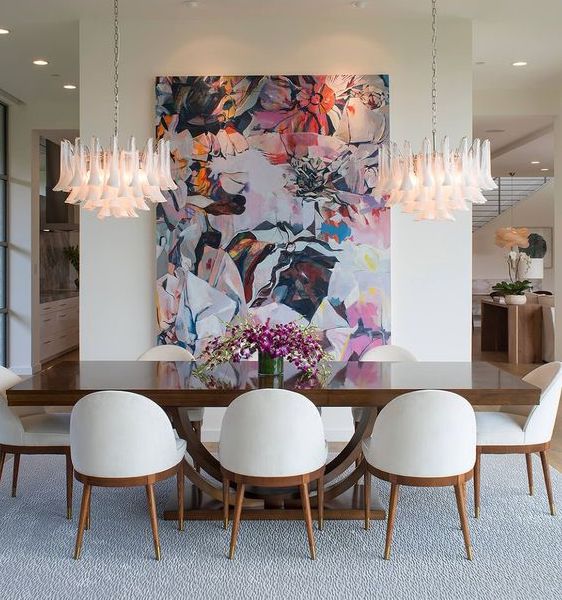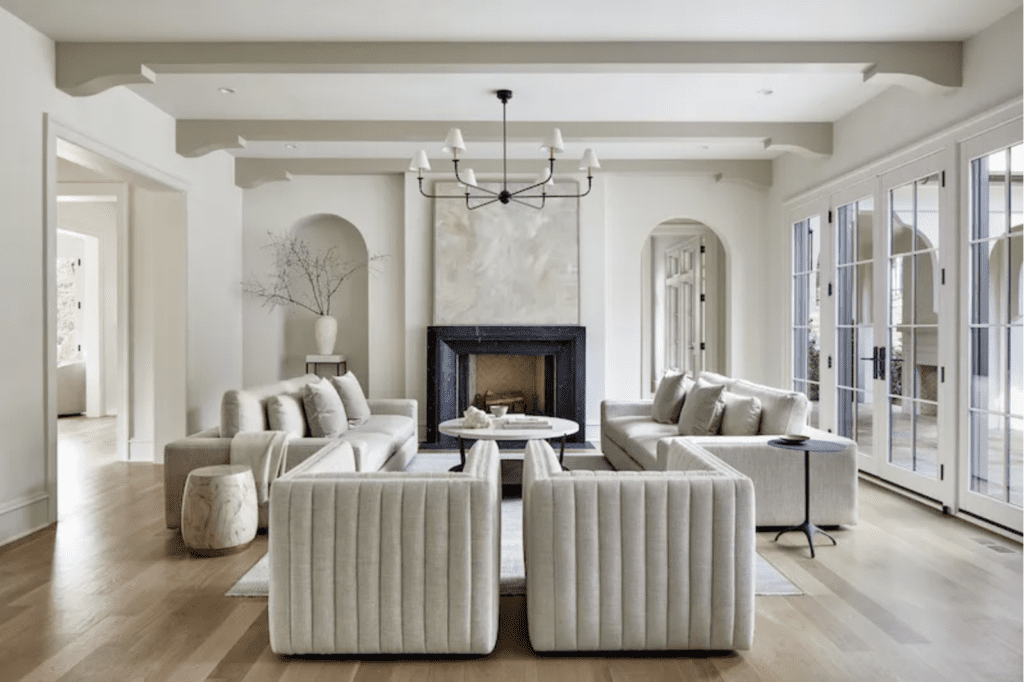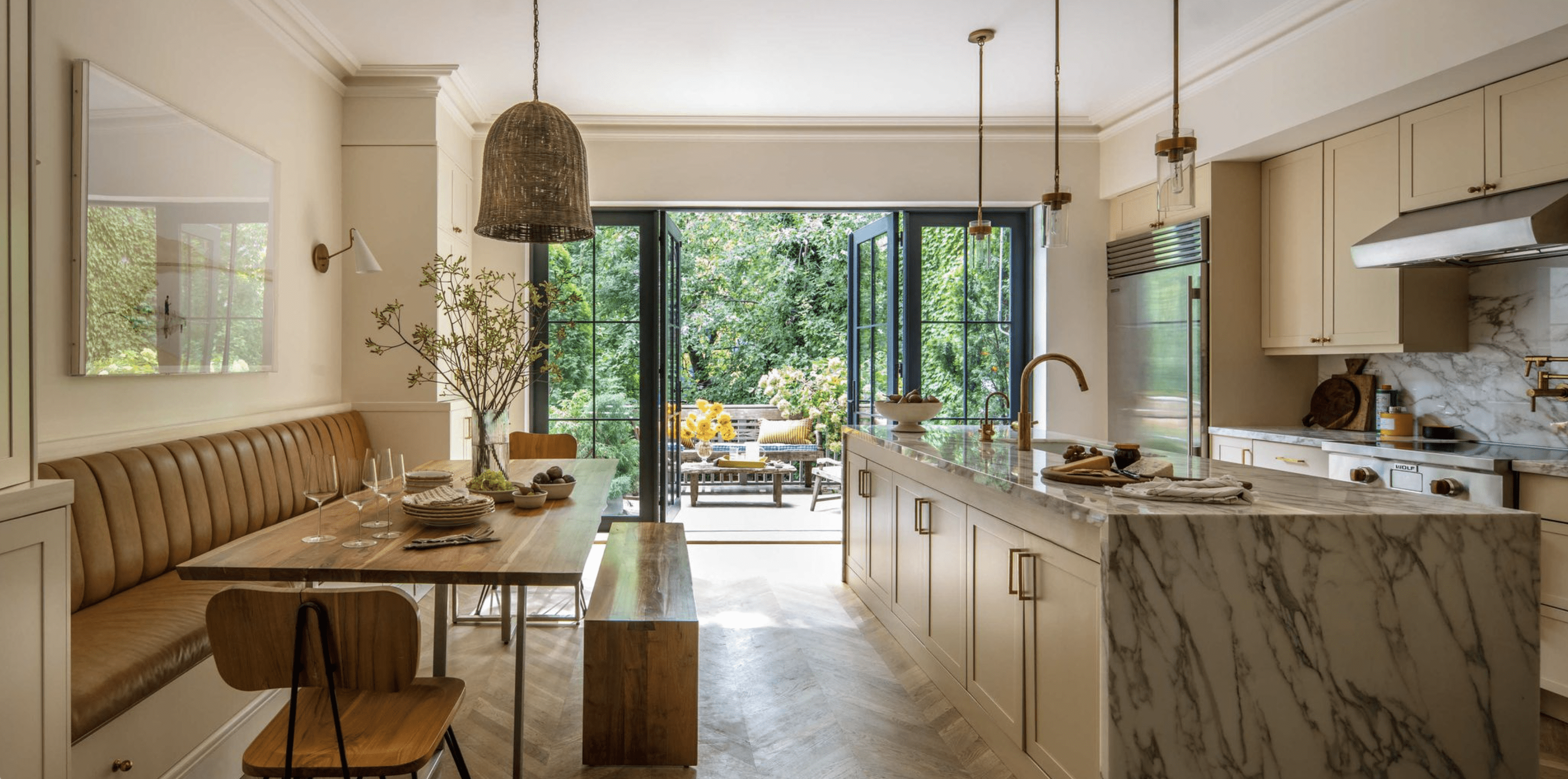
Balancing design trends with timeless design elements is a delicate art that ensures your space remains visually appealing and relevant over the long term. As an interior designer, I am often asked some variation of these questions by my clients:
- “How can I incorporate this trend that I see everywhere without dating my home in a few years?”
- “How can I ensure that I won’t get tired of the things I choose today?”
- “I love this design feature but it seems like everyone is doing it these days. Am I going to regret it later if I use it in my home?”
- “I know what I like today, but how can I make sure that I will still love it in five or ten years?”
These are all valid questions, and it is my job to provide peace of mind to my clients that we can achieve the perfect balance of trendiness and timelessness in their design plan. Here are some strategies I use achieve this balance:
1. Start with a Strong Foundation
Begin by establishing a solid base of timeless design elements that have an enduring and classic quality and that transcend the ebb and flow of design trends. Here are some examples of timeless design elements that will create a good base to build upon:
- Neutral colors like white, beige, grey, and soft pastels create a timeless backdrop that can easily be complemented by different styles and trends.
- Wood, stone, marble, and natural fibers like wool and cotton add a sense of warmth and authenticity to any space.
- Well-crafted, quality furniture pieces with clean lines and simple silhouettes tend to remain relevant regardless of changing trends.
- Classic architectural features like crown molding, wainscoting, and coffered ceilings add depth and character to a space without being overly ornate.
- Subtle and versatile patterns like stripes, herringbone, and chevron can be used in various ways without feeling outdated.
- Symmetrical arrangements and layouts create a sense of balance and order that is pleasing to the eye and can stand the test of time.
- Classic lighting fixtures, such as chandeliers, pendant lights, and wall sconces, can add a touch of elegance and timelessness to any room.
- Quality hardware, such as knobs, handles, and faucets, can add a touch of elegance and longevity to your design.
Remember that timeless design is about creating a cohesive and enduring look that resonates with your personal style. These elements can serve as a foundation to build upon and adapt as your design preferences evolve.
2. Focus on Layout and Functionality
Timeless design is not just about aesthetics; it also involves creating a functional and efficient layout. Prioritize the flow and usability of the space, ensuring that it meets your practical needs before delving into trendy aesthetics. Here are some factors to consider when creating a functional layout:
- Begin by understanding your lifestyle and the specific needs of your household. Consider factors such as the number of occupants, their ages, daily routines, and any special requirements.
- Divide your home into different activity zones based on common activities. For example, you might have a living zone for relaxation, a dining zone for meals, a work/study zone, and a sleeping zone. This helps you allocate space effectively.
- Ensure that there is a logical flow between different zones. For example, the kitchen should be conveniently located near the dining area, and bedrooms should have easy access to bathrooms. Minimize obstructions and create clear pathways.
- Arrange furniture based on the activities you’ll perform in each zone. Each zone should have a focal point such as a piece of artwork, a fireplace, or a TV. Place seating areas near focal points.
- Anticipate the natural movement of people through the space. Avoid placing furniture or obstacles in high-traffic areas to prevent congestion.
- Choose furniture and decor that are appropriately scaled for the room. Oversized furniture in a small space can feel cramped, while small pieces in a large room can feel lost.
- Integrate ample storage solutions into your layout to keep clutter at bay. Consider built-in shelves, cabinets, and multi-functional furniture like ottomans with storage.
- Plan for flexibility and adaptability. Choose furniture that can serve multiple purposes, such as a sofa bed for guests or a dining table that can be extended for gatherings.
Creating a functional layout in your home involves careful planning and consideration of how you and your family use the space. Remember, a functional layout should prioritize your comfort, convenience, and the way you use your home. It’s about creating a space that enhances your daily life and reflects your personal style.

3. Use Trends Sparingly
Integrate design trends in small, easily changeable elements. For example, you could incorporate trendy patterns through throw pillows, artwork, or accessories. This allows you to update the look without a major overhaul when the trend fades. Some current trend that you could explore include:
- Maximalism: Bold and vibrant patterns, colors, and textures combined in a harmonious way to create visually rich and expressive spaces.
- Bold Wallpapers: Large-scale, artistic, and bold wallpapers are being used to create statement walls and add drama to rooms.
- Dark and Moody Interiors: Deep, rich color palettes like navy, charcoal, and deep greens combined with plush textures for a luxurious and moody atmosphere.
- Japandi Style: A fusion of Japanese minimalism and Scandinavian design, characterized by simplicity, natural materials, and a calm, serene ambiance.
- Curved and Organic Shapes: Furniture and decor featuring soft curves and organic forms, moving away from sharp lines for a more inviting look.
- Earth Tones: Warm and earthy color palettes, including shades of terracotta, deep greens, ochre, and olive are gaining popularity.
Keep in mind that while it’s fun to incorporate current trends, it’s important to do so in a way that complements your personal style and the existing elements of your home. Trends come and go, so consider using them in ways that are easy to update or change as your tastes evolve over time.
4. Opt for Classic Patterns and Textures
Incorporate patterns and textures that are classic and enduring. Subtle stripes, herringbone, and solid textures are less likely to feel dated compared to bold, overly specific patterns that are trendy for a short period. Classic patterns can add depth, character, and a timeless aesthetic to your space. Here are some creative ways to use these elements:
- Wallpapers: Choose classic patterns like botanicals, stripes, herringbone, or textural finishes for an accent wall or an entire room. Wallpaper can instantly transform a space and create a sophisticated atmosphere.
- Upholstery and Fabrics: Use classic patterns on upholstery, curtains, bedding, and throw pillows. Consider plaids, checks, floral prints, and traditional geometrics to add visual interest to furniture and soft furnishings.
- Area Rugs: Opt for rugs with timeless patterns like Persian motifs, Oriental designs, or Greek key patterns. Rugs can define a space and add warmth underfoot.
- Tile Work: Incorporate classic patterns through tile designs in kitchens, bathrooms, and even entryways. Patterns like chevron, hexagon, and subway tiles can create a vintage or traditional look.
- Moldings and Trim: Enhance walls and ceilings with classic moldings, such as crown molding, wainscoting, and beadboard, to add architectural interest and elegance.
- Textured Wall Treatments: Add texture with techniques like stucco, plaster, or shiplap. These classic textures can bring depth to walls and create a cozy ambiance.
- Wood Paneling: Install wood paneling to create a focal point, an accent wall, or an interesting feature throughout a room.
- Artwork and Decor: Choose artwork, mirrors, and decor items with classic patterns and textures. For example, framed botanical prints or vintage tapestries can add a touch of timeless elegance.
The key to using classic patterns and textures effectively is to balance them with other design elements in your space. Mix and match patterns thoughtfully and consider the overall theme and color palette of your home for a cohesive and visually appealing result.
5. Use a Neutral Color Palette
While pops of trendy colors can be added through accessories, sticking to a neutral color palette for larger elements like walls, furniture, and flooring creates a timeless backdrop that can accommodate various trends. A few pointers to keep you on track:
- Whites, greys, beige, taupe, and soft pastels are classic choices that provide a versatile backdrop for any style.
- Select an accent color that complements your neutral base. This could be a bold hue like emerald green, vibrant coral, or rich navy, or a muted tone like olive green, soft rose, or slate blue – whatever color is currently in vogue and appeals to you.
- Integrate the accent color in smaller, impactful doses. Focus on accessories, accent furniture, decorative items, and textiles like throw pillows, artwork, or curtains.
- Use your accent color to create focal points in the room. For instance, a standout piece of furniture, a bold accessory, or a piece of artwork can draw attention and infuse energy.
- Combine neutral and accent-colored accessories for a balanced look. Group items like vases, candles, and decorative objects to create visual interest and showcase the accent color.
- Rotate or update your accents seasonally to keep the space feeling fresh and current. This way, you can easily adapt to new trends as they emerge.
- Avoid overwhelming the space with too much of the accent color. Balance is key to creating a cohesive and visually pleasing design.
The goal is to achieve a seamless blend between timeless neutrals and trendy accents. This approach allows you to enjoy the best of both worlds while creating a space that feels current and inviting.
6. Invest in Quality Pieces
When it comes to furniture and fixtures, invest in high-quality pieces that are built to last. These pieces often have a timeless aesthetic and can be complemented with more contemporary and changeable accessories. Finding quality furniture and fixtures for your home is essential for creating a comfortable and enduring living space. Here are some steps to help you locate and select high-quality items:
- Establish a Budget: Determine how much you’re willing to invest in furniture and fixtures. Quality often comes with a higher price tag, but setting a budget helps you prioritize and make informed decisions.
- Research Brands and Manufacturers: Look for reputable brands and manufacturers known for producing well-made and durable furniture. Read reviews, ask for recommendations, and explore their track record.
- Visit Showrooms and Stores: Visit furniture showrooms, home furnishing stores, and design centers in your area. Seeing the pieces in person allows you to assess their quality, craftsmanship, and materials.
- Pay Attention to Materials and Construction: Examine the materials used in furniture construction. Solid wood, sturdy metals, and quality fabrics or leather are indicators of well-made pieces. Avoid furniture with flimsy or cheap materials.
- Inspect Joinery and Finishes: Look at how furniture pieces are joined together. Dovetail joints, mortise and tenon, and other quality joinery methods indicate sturdy construction. Also, check for smooth finishes and attention to detail.
- Ask About Upholstery: If you’re purchasing upholstered furniture, inquire about the type of foam, padding, and springs used. Quality upholstery will be comfortable and resilient.
- Antiques and Vintage Shops: Consider shopping at antique stores and vintage shops. Older pieces are often well-made and can add character to your home.
- Work with a Designer: If your budget allows, consider working with an interior designer. They have access to trade resources and can help you source quality pieces that align with your style and budget.
Remember, investing in quality furniture and fixtures is a long-term decision that contributes to the overall comfort, aesthetics, and value of your home. Take your time, do thorough research, and prioritize items that will truly enhance your living space.

7. Blend Old and New
Merge classic and contemporary elements to create a harmonious blend. For instance, pair antique furniture with modern lighting fixtures or combine traditional architectural details with sleek, minimalist furniture. Mixing old and new furniture and decor is a fantastic way to create a unique and balanced interior design that showcases your personal style. Here are some tips to help you achieve a harmonious blend of old and new elements:
- Start by defining your design style. Are you drawn to traditional, modern, rustic, or eclectic aesthetics? Understanding your preferences will guide you in selecting pieces that complement each other.
- Choose a cohesive color palette that ties your old and new pieces together. Consider using a neutral base and adding pops of color through accents and accessories.
- Designate focal points in the room where you can showcase both old and new items. This could be a fireplace, a prominent wall, or a piece of furniture that stands out.
- Match materials, finishes, scale and proportions between old and new pieces. For example, if you have an antique wooden table, pair it with modern chairs that have a similar wood tone.
- Group old and new items together to create intentional visual clusters. This could be a collection of vintage vases displayed alongside contemporary artwork.
- Incorporate transitional pieces that bridge the gap between old and new. These pieces often have a timeless quality and can harmonize various design elements.
- Ultimately, your personal taste and instincts play a significant role. If an arrangement feels harmonious to you, it’s likely to work well in the overall design.
Keep in mind that the goal is to create a space that feels cohesive, balanced, and reflective of your individual style. Experiment, take your time, and enjoy the process of curating a mix of old and new furniture and decor.
8. Personalize and Balance the Space
Infuse your own personality into the design to make the space unique. Balance trendy items with elements that have sentimental value or personal meaning, creating a space that feels both current and timeless. Here are some effective ways to infuse your personal touch into your living space:
- Showcase your own artwork, photography, or creative projects on the walls. This adds a personal and meaningful touch to your home.
- Curate a collection of framed photos, artwork, and mementos on a gallery wall to tell a visual story of your life and experiences.
- Display collections of items that you’re passionate about, whether it’s books, vintage vinyl records, figurines, or sports memorabilia.
- Use scented candles, essential oils, or room sprays with scents that evoke positive memories and feelings.
- Dedicate a corner or room to your hobbies, whether it’s a home gym, a crafting station, a reading nook, or a musical instrument setup.
- Decorate with items you’ve collected during your travels, such as textiles, artwork, or souvenirs from different places.
- Incorporate your favorite colors into the decor, whether through accent pillows, throws, artwork, or wall paint.
- Include elements from your cultural background or heritage, such as traditional textiles, art, or crafts.
- Embrace handcrafted furniture, pottery, and textiles that add a personal touch and support local artisans.
The key to personalizing your home is to create a space that feels authentic and meaningful to you. Don’t be afraid to experiment and take risks to create a living environment that truly represents who you are.
9. Use Natural and Sustainable Materials
Incorporating natural and sustainable materials, such as wood, stone, and natural fibers, adds an organic and enduring quality to your design. These materials tend to transcend design trends. Deciding where to use natural and sustainable materials in your home involves thoughtful consideration of both aesthetics and functionality. Here are some steps to help you make informed decisions:
- Determine your priorities for using natural and sustainable materials. Are you aiming to reduce environmental impact, improve indoor air quality, or support local artisans? Clarifying your goals will guide your choices.
- Incorporate natural and sustainable materials in spaces where you spend a lot of time, such as the bedroom and living room. Consider organic cotton bedding, natural fiber rugs, and non-toxic paints.
- Invest in sustainable furniture pieces made from reclaimed wood, FSC-certified wood, or other eco-friendly materials. Choose upholstery made from natural fibers like organic cotton or wool.
- Consider sustainable materials that contribute to energy efficiency, such as insulated windows, energy-efficient doors, and recycled insulation.
- Source materials locally to support your community and reduce transportation-related environmental impact. Local materials often have a unique charm that adds character to your home.
- Integrate natural and sustainable materials that align with your personal aesthetic and design preferences. This ensures that your home feels cohesive and reflective of your style.
- Evaluate the maintenance requirements of different materials. Some sustainable materials may require special care or finishes to maintain their appearance over time.
- Choose materials with a long lifespan to reduce the need for frequent replacements, which is both sustainable and cost-effective.
- If you’re uncertain about which sustainable materials to use, consult with architects, interior designers, or sustainable building experts who can provide guidance based on your specific needs and goals.
By carefully considering where to use natural and sustainable materials, you can create a home that is not only aesthetically pleasing but also environmentally responsible and conducive to a healthier living environment.

10. Pay Attention to Details
Small details, like moldings, trim, and hardware, can contribute to a timeless appeal. Thoughtful attention to these details can elevate the overall design, keep it from feeling dated, and ensure a timeless and enduring aesthetic. Here are some design strategies to consider:
- Incorporate timeless architectural details like crown molding, wainscoting, and coffered ceilings. These features add depth and sophistication to your space.
- Choose high-quality materials such as hardwood floors, natural stone, and solid surfaces for countertops. Quality materials not only look timeless but also age gracefully.
- Opt for furniture, cabinetry, and decor with clean and simple lines. Avoid overly ornate or overly trendy designs that might become outdated quickly.
- Embrace a transitional design style that blends classic and contemporary elements. This approach allows you to incorporate both timeless and current design elements.
- Choose lighting fixtures with a timeless design, such as classic chandeliers, pendant lights, and wall sconces. These fixtures can be versatile and enduring.
- Opt for neutral window treatments like curtains or blinds. Avoid overly bold or patterned window coverings that may become dated.
- Invest in classic furniture shapes that have stood the test of time. Pieces like a Chesterfield sofa or a Eames lounge chair can maintain their appeal over the years.
- Select hardware with a classic and versatile design. Details like door handles, drawer pulls, and faucets should have a timeless quality.
- Incorporate natural and organic elements like wood, stone, and plants. These elements create a connection to nature and have a timeless appeal.
- Layer different textures to add depth and interest to your design. Combining materials like leather, velvet, and metal can create a rich and timeless atmosphere.
By carefully considering these design details, you can create a home that remains relevant and appealing for years to come, avoiding the risk of feeling dated as design trends evolve.
11. Update Regularly
Design trends evolve over time, so it’s essential to periodically assess and update your space. As you make updates, focus on maintaining a balance between existing timeless elements and incorporating new trends. Deciding how often to change the design of your home to stay current with trends is a personal choice that depends on various factors. Here are some considerations to help you determine the right frequency for updating your home’s design:
- Personal Preference: Consider how much you enjoy updating your living space. Some people love keeping up with the latest trends and frequently refresh their home, while others prefer a more stable and timeless design.
- Budget: Updating your home’s design can incur costs, especially if you’re making significant changes. Assess your budget and determine how much you’re willing to invest in design updates.
- Lifestyle Changes: Changes in your lifestyle, such as a growing family, a new job, or new hobbies, might necessitate design updates to accommodate your evolving needs.
- Resale Value: If you plan to sell your home in the future, consider how frequently changing trends might affect the resale value. Striking a balance between trendy and timeless can attract potential buyers.
- Maintenance and Effort: Updating your home’s design requires time and effort. Consider how much effort you’re willing to put into maintenance and how frequently you’re comfortable making changes.
- Seasonal Updates: Some homeowners opt for seasonal updates, changing smaller decor elements like cushions, throws, and accessories to refresh the look without a major overhaul.
Ultimately, the decision to update your home’s design should align with your personal style, budget, and lifestyle. Regularly reassess your design choices and make updates that bring you joy and enhance your living experience.
Remember that the key is to create a space that feels authentic, functional, and visually appealing to you while incorporating elements that have proven to withstand changing design trends. If you’re unsure about striking the right balance, you can always consider working with an interior designer. They are skilled at balancing design trends with timeless design elements and can help you create a cohesive design that suits your preferences.
